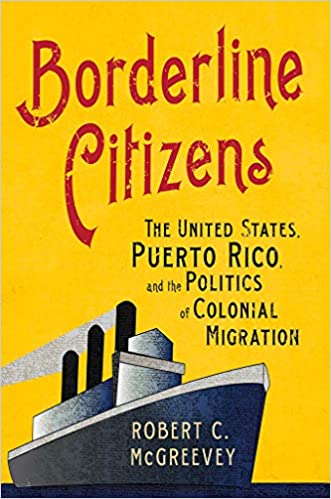The Book
Borderline Citizens: The United States, Puerto Rico, and the Politics of Colonial Migration
The Author(s)
Robert C. McGreevey

Robert C. McGreevey’s Borderline Citizens: The United States, Puerto Rico, and the Politics of Colonial Migration traces the political history of Puerto Rican migration to the United States from the years immediately following the Spanish-American War to the advent of the Great Depression. Although the book is framed around Puerto Rican migratory waves to the U.S., its most compelling story is that of the interaction among labor leaders and movements in Puerto Rico and the United Sates.
Focusing mostly on the legal contests over Puerto Ricans’ place in the American polity, the book details how Puerto Ricans’ ambiguous status as colonial subjects affected their integration into the U.S. labor market. McGreevy outlines how race, poverty, and conceptions of the “white man’s burden” combined to create a vision of the island that was simultaneously pitiful and threatening, and which dictated where on the population hierarchy these colonial subjects/workers should fall. I found particularly captivating McGreevey’s discussion of the interactions between the Puerto Rican labor leader Santiago Iglesias and his American counterpart Samuel Gompers (the focus of Chapter 3). As the author contends, U.S. labor leaders’ approach to the island’s labor problems mirrored the political battles happening in the legal realm, which “combine[d] support with exclusion” to simultaneously grant Puerto Ricans privileges over other immigrant groups while still marking them as foreign, and thus unequal to dominant white society (91).
Another one of McGreevey’s great contributions is his analysis of the limits of the classification of individual as “legal/citizens” or “illegal/noncitizens.” As he very cogently states, the way in which the U.S. legal system defined and treated Puerto Ricans “challenges the notion that the categories of citizen and noncitizen immigrant have always been legally distinct and historically opposite” (176). Through its coverage of the negotiation that went into the eventual concession of American citizenship to Puerto Ricans, the book shows that these colonial subjects never quite fit neatly into either one of the categories, holding instead an ambiguous position between native and foreign.
Overall, Borderline Citizens attempts to explain how the relationship between legal categories and migration/immigration play out in a colonial setting. The book shows that definitions never purely follow a “top-down” approach but rather reflect the constant negotiations among different stratified groups. As such, McGreevey shows that Puerto Ricans are not simple recipients of a legal categorization, but that instead they had a say in creating that unique definition of their place in U.S. society.
About the Reviewer
Naida García-Crespo is an independent researcher with a PhD in English from the University of Illinois in Urbana Champaign. Her work has appeared in Film History, Early Popular Visual Culture, and CENTRO Journal, among other journals. She is the author of Early Puerto Rican Cinema and Nation Building (1897-1940): National Sentiments, Transnational Realities (Bucknell University Press, 2019).

0